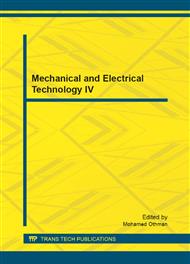[1]
Q.L. An ,Y.C. Fu ,J.H. Xu, Experimental study on turning of TC9 titanium alloy with cold water mist jet cooling, International Journal of Machine Tools & Manufacture 51(2011)549-555.
DOI: 10.1016/j.ijmachtools.2011.03.005
Google Scholar
[2]
S. Sun , M. Brandt , M.S. Dargusch, Characteristics of cutting forces and chip formation in machining of titanium alloys, International Journal of Machine Tools & Manufacture49 (2009) 561~568.
DOI: 10.1016/j.ijmachtools.2009.02.008
Google Scholar
[3]
Rupinder Singh, J.S. Khamba, Ultrasonic machining of titanium and its alloys: A review, Journal of Materials Processing Technology173 (2006) 125–135.
DOI: 10.1016/j.jmatprotec.2005.10.027
Google Scholar
[4]
Singh, R. , Investigation for ultrasonic machining of titanium and its alloys, Journal of Materials Processing Technology 183( 2-3)( 2007) 363-367.
DOI: 10.1016/j.jmatprotec.2006.10.026
Google Scholar
[5]
X. Li, J.L. Gaddis, T. Wang, Modeling of heat transfer in a mist/steam impinging jet, Journal of Heat Transfer 123 (6) (2001) 1086–1092.
DOI: 10.1115/1.1409262
Google Scholar
[6]
J.Y. Liu, R.D. Han, Y.F. Sun, Research on experiments and action mechanism with water vapor as coolant and lubricant in green cutting, International Journal of Machine Tools and Manufacture 45 (2005) 687–694.
DOI: 10.1016/j.ijmachtools.2004.09.022
Google Scholar
[7]
S.W. Kim, C.M. Lee, D.W. Lee, J.S. Kim, Evaluation of machinability by cutting environments in high-speed milling of difficult-to-cut materials, Journal of Materials Processing Technology 111 (2001) 256–260.
DOI: 10.1016/s0924-0136(01)00529-5
Google Scholar
[8]
H.Z. Choi, S.W. Lee, A comparison of the cooling effects of compressed cold air and coolant for cylindrical grinding with a CBN wheel, Journal of Materials Processing Technology 111 (2001) 265–268.
DOI: 10.1016/s0924-0136(01)00531-3
Google Scholar
[9]
Y. Su, N. He, L. Li, A. Iqbal, M.H. Xiao, S. Xu, B.G. Qiu, Refrigerated cooling air cutting of difficult-to-cut materials, International Journal of Machine Tools and Manufacture 47 (2007) 927–933.
DOI: 10.1016/j.ijmachtools.2006.07.005
Google Scholar
[10]
J. Liu, Y. Kevin Chou, On temperatures and tool wear in machining hyper- eutectic Al–Si alloys with vortex-tube cooling, International Journal of Machine Tools and Manufacture 47 (2007) 635–645.
DOI: 10.1016/j.ijmachtools.2006.04.008
Google Scholar
[11]
S. Sun, M. Brandt, M.S. Dargusch, Machining Ti–6Al–4V alloy with cryogenic compressed air cooling, International Journal of Machine Tools and Manu- facture 50 (2010) 933–942.
DOI: 10.1016/j.ijmachtools.2010.08.003
Google Scholar
[12]
K.A. Venugopal,S. Paul A.B. Chattopadhyay, Growth of tool wear in turning of Ti–6Al–4V alloy under cryogenic cooling, Wear 262(2007)1071–1078.
DOI: 10.1016/j.wear.2006.11.010
Google Scholar
[13]
F. Pusavec, P. Krajnik,J. Kopac, Transitioning to sustainable production—part I: application on machining technologies, Journal of Cleaner Production18 (2010) 174–184.
DOI: 10.1016/j.jclepro.2009.08.010
Google Scholar


